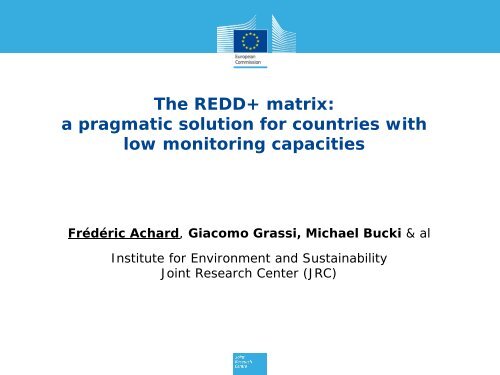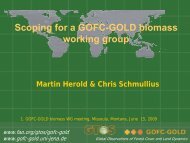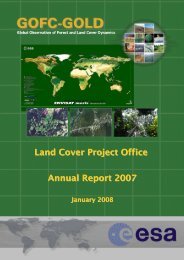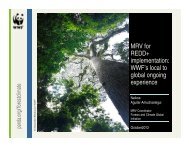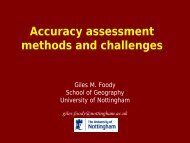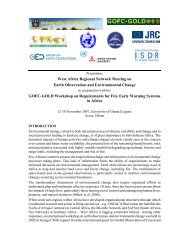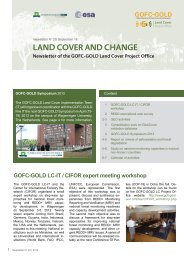The REDD+ matrix: a pragmatic solution for countries with low ...
The REDD+ matrix: a pragmatic solution for countries with low ...
The REDD+ matrix: a pragmatic solution for countries with low ...
Create successful ePaper yourself
Turn your PDF publications into a flip-book with our unique Google optimized e-Paper software.
<strong>The</strong> <strong>REDD+</strong> <strong>matrix</strong>:<br />
a <strong>pragmatic</strong> <strong>solution</strong> <strong>for</strong> <strong>countries</strong> <strong>with</strong><br />
<strong>low</strong> monitoring capacities<br />
Frédéric Achard, Giacomo Grassi, Michael Bucki & al<br />
Institute <strong>for</strong> Environment and Sustainability<br />
Joint Research Center (JRC)
Introduction<br />
Until now, a major share of readiness ef<strong>for</strong>ts are allocated into MRV of<br />
<strong>for</strong>est carbon stocks (on average 40% according to World Bank and<br />
UN-REDD)<br />
Focusing readiness phase too much on "accurate MRV" might lead to a<br />
<strong>REDD+</strong> mechanism which works well only <strong>for</strong> a few <strong>countries</strong>.<br />
Is it possible setting up simplified monitoring/reporting<br />
requirement al<strong>low</strong>ing to join <strong>REDD+</strong> also to those Parties <strong>with</strong><br />
limited <strong>for</strong>est monitoring capacity
IPCC basics to estimate <strong>for</strong>est C stock changes<br />
Emissions = activity data (AD) x emission factor (EF)<br />
Six land use classes: Forest land, Cropland, Grassland, Wetlands, Settlements, Other lands<br />
Methods to estimate C stock changes:<br />
Gain-Loss: growth – harvest – other losses (in theory <strong>for</strong> all tiers)<br />
Stock Change: difference of C stock over time (tier 2/3 <strong>for</strong> land use remaining the same, all<br />
tiers <strong>for</strong> land use changes)<br />
IPCC guidance requires tier-2/3 methods <strong>for</strong> emission factors in "Key Categories"<br />
(likely including de<strong>for</strong>estation and degradation in most developing <strong>countries</strong>)<br />
However, most developing <strong>countries</strong> seems not ready yet <strong>for</strong> tier 2 or 3
How <strong>REDD+</strong> activities would fit into IPCC land uses<br />
From<br />
to<br />
Forest Land<br />
Other Land<br />
Forest Land<br />
Other Land<br />
Forest Degradation<br />
Forest conservation<br />
Sustainable Management of Forests<br />
Enhancement of carbon stocks<br />
Enhancement of carbon stocks<br />
(Af<strong>for</strong>estation/ Re<strong>for</strong>estation)<br />
De<strong>for</strong>estation<br />
Stock change method: C be<strong>for</strong>e – C after<br />
Gain-loss: growth – harvest – other losses<br />
Difficult to get data<br />
IPCC (very uncertain)<br />
FAOSTAT: very difficult to get the right data!<br />
It is unlikely to estimate C stock changes from degradation <strong>with</strong> tier 1 !
Don’t <strong>for</strong>get <strong>for</strong>est degradation!<br />
Estimates of carbon emissions from <strong>for</strong>est degradation<br />
(expressed as an additional percentage to the emissions from de<strong>for</strong>estation)<br />
Additional emissions<br />
Study Area<br />
due to <strong>for</strong>est<br />
degradation<br />
Reference<br />
Humid tropics +6% Achard et al 2004<br />
Brazilian Amazon,<br />
Peruvian region<br />
+25-47% Asner et al 2005<br />
Tropical regions +29% Houghton 2003<br />
South East Asia +25-42%<br />
Houghton and Hackler<br />
1999<br />
Tropical Africa +132% Gaston et al 1998
Modified IPCC land use transition <strong>matrix</strong><br />
To<br />
Forest land<br />
“Intact (natural)<br />
“non-intact<br />
Other Land<br />
From<br />
Forest”<br />
Forest”<br />
Forest<br />
land<br />
“Intact<br />
(natural)<br />
Forest”<br />
“nonintact<br />
Forest”<br />
Forest<br />
conservation<br />
Enhancement of<br />
C stocks<br />
(<strong>for</strong>est<br />
restoration)<br />
Forest<br />
Degradation<br />
Sustainable<br />
Management of<br />
Forests<br />
De<strong>for</strong>estation<br />
De<strong>for</strong>estation<br />
Other Land -<br />
Enhancement of<br />
C stocks<br />
(A/R)<br />
Stock change method: C be<strong>for</strong>e – C after<br />
Gain-loss: growth – harvest – other losses
How to map “non – intact” <strong>for</strong>ests<br />
TREES-3<br />
Forest cover change<br />
Assessment<br />
Indonesia<br />
Kalimantan<br />
Logging and Forest<br />
Conversion<br />
(1990-2000 period)
Spatial pattern approach to identify “exposed <strong>for</strong>ests” as<br />
proxy to “non-intact <strong>for</strong>ests”<br />
Among different possible approaches, we consider that “<strong>for</strong>est edges”<br />
may be used as a simple and <strong>pragmatic</strong> proxy to identify non-intact<br />
areas (“exposed <strong>for</strong>ests”), or at least may be a first step to be<br />
complemented by other more accurate (and more costly) approaches<br />
(i.e. high-re<strong>solution</strong> RS).<br />
<strong>The</strong> underlying assumption is that <strong>for</strong>ests that are sufficiently remote<br />
from non <strong>for</strong>ested areas (i.e. at a certain distance from roads,<br />
navigable waters, crops, grasslands, mines, etc.) are protected<br />
against significant anthropogenic degradation.
Example of identification of “exposed <strong>for</strong>ests”<br />
- Input: Binary <strong>for</strong>est maps<br />
(FACET)<br />
- Re<strong>solution</strong>: 60x60 m².<br />
- Treatment: Morphological<br />
Spatial Pattern Analysis<br />
(MSPA).<br />
- Biome specific: Rain<strong>for</strong>est in<br />
Congo Basin (Edge size=500m).<br />
- Could as well be called<br />
«exposed», «potentially<br />
degraded », « managed » or<br />
simply«other»<strong>for</strong>ests.
Example of use of “intact <strong>for</strong>est Landscape” concept<br />
As proxy <strong>for</strong> intact (natural) <strong>for</strong>ests<br />
Maps of changes in IFLs in Congo<br />
basin:<br />
- from 2000 to 2005<br />
- from 2005 to 2010<br />
Reference:<br />
Thies et al., Intact <strong>for</strong>est<br />
landscapes: Case study: the Congo<br />
basin, Greenpeace 2011
Example of use of “intact <strong>for</strong>est Landscape” concept
Case study in Democratic Republic of Congo<br />
Area transition matrices <strong>for</strong> one biome (Congo rain<strong>for</strong>ests), 000 ha<br />
a) 2000-2005 b) 2005-2010<br />
NF<br />
NIF<br />
OL<br />
Total<br />
NF<br />
NIF<br />
OL<br />
total<br />
2005<br />
2005<br />
2005<br />
2000<br />
2010<br />
2010<br />
2010<br />
2005<br />
NF<br />
2000<br />
62,869 587 36 63,492<br />
NFL<br />
2005<br />
62,273 538 57 62,869<br />
NIF<br />
2000<br />
- 39,610 327 39,937<br />
NIF<br />
2005<br />
- 39,559 638 40,197<br />
OL<br />
2000<br />
0 - 125,011 125,011<br />
OL<br />
2005<br />
0 - 125,374 125,374<br />
Total<br />
2005<br />
62,869 40,197 125,374 228,440<br />
Total<br />
2010<br />
62,273 40,097 126,069 228,440<br />
NF = Natural Forest land. NIF = Non Intact Forest Land. OL = Other Land<br />
Note: Available input maps did not reflect Af<strong>for</strong>estation, Re<strong>for</strong>estation or Restoration, <strong>for</strong> methodological purposes the shaded<br />
cells could there<strong>for</strong>e not be properly computed and were left blank.
Area based hypothetical Reference level<br />
De<strong>for</strong>estation<br />
(in 5 yrs)<br />
Degrad.<br />
(5 yrs)<br />
Sust.<br />
Manag.<br />
Conserv.<br />
NF to OL<br />
NIF to<br />
OL<br />
NF to NIF<br />
NIF to<br />
NIF<br />
NF to NF<br />
Historical 2000-2005 36 327 587 39,610 62,869<br />
+50%<br />
+50%<br />
+100%<br />
Area<br />
Ref. Level 2005-2010<br />
=<br />
=<br />
=<br />
39,706 61,641<br />
(10 3<br />
54<br />
491<br />
1,173<br />
ha)<br />
Actual 2005-2010 57 638 538 39,559 62,273<br />
Difference<br />
(Actual - RL)<br />
+3 +147 -635 -147 +632<br />
NF = Natural/Intact Forest land. NIF = Non Intact Forest land. OL = Other Land
Estimating C stock changes <strong>for</strong> REDD activities<br />
Once the transition <strong>matrix</strong> <strong>for</strong> AD is done, each AD need to be multiplied by<br />
the relevant EF, to get C stock change <strong>for</strong> each <strong>REDD+</strong> activity.<br />
If tier 1 EF are to be used, it would require asking IPCC to produce<br />
estimates of C stocks (by <strong>for</strong>est / climate type) <strong>for</strong>:<br />
- “intact <strong>for</strong>est" (values already existing)<br />
- “non intact <strong>for</strong>ests" (from the literature).<br />
This will al<strong>low</strong> to derive estimate of C stock changes + uncertainty<br />
estimates <strong>for</strong> De<strong>for</strong>estation and Degradation.<br />
<strong>The</strong> proposed approach requires that the same tier-1 EF (stratified by<br />
<strong>for</strong>est & climate type) are used in both RL and in the accounting period<br />
-> This means that the errors of EF in the Ref Lev and accounting period<br />
are fully "correlated“.
De<strong>for</strong>estation<br />
(in 5 yrs)<br />
Degrad.<br />
(5 yrs)<br />
Sust.<br />
Manag.<br />
Conserv.<br />
Total<br />
NF to OL<br />
NIF to<br />
OL<br />
NF to NIF<br />
NIF to<br />
NIF<br />
NF to NF<br />
Area<br />
(10 3 ha)<br />
Difference Actual - RL +3 +147 -635 -147 +632 0<br />
C losses (-), tC/ha (a) -150 -73 -78<br />
C increment (+), tC/ha/yr 1.6 0.5<br />
Cumulated credits(+) or<br />
debits (-) in 2010, MtC (b) -0.4 -10.6 49.2 -1.1 1.5 38.6<br />
NF = Natural/Intact Forest land. NIF = Non Intact Forest Land. OL = Other Land<br />
(a) Assuming the fol<strong>low</strong>ing values of biomass carbon stocks: NFL: 155 tC/ha (IPCC 2006); EFL: NFL/2 (or 50%<br />
degradation on average in exposed <strong>for</strong>ests); OL: 5 tC/ha.<br />
(b) Calculated as the difference in area (Actual minus RL) multiplied by the C stock change
Taking uncertainties into account<br />
We obtained an estimate of C stock changes <strong>for</strong> all REDD activities (accounting<br />
period - RL) obtained <strong>with</strong> adequate methods <strong>for</strong> AD but un-adequate methods <strong>for</strong><br />
EF (tier 1 instead of tier 2/3)<br />
NF NIF OL<br />
Tier-1 C stocks (tC/ha) 155 78 5<br />
Uncertainty % (1) 50% 75% 50%<br />
NF to OL NIF to OL NF to NIF<br />
Tier-1 C stock change (tC/ha) 150 73 78<br />
Uncertainty % (1) 52% 80% 125%<br />
NFL = Natural/Intact Forest land. NIF = Non Intact Forest Land. OL = Other Land<br />
(1)<br />
At 95% confidence interval<br />
When the uncertainties above are combined, total uncertainty of the<br />
emission reduction becomes 99%<br />
How to consider that this country used tier 1 EF <strong>for</strong> key category
As part of the Kyoto Protocol review process, the UNFCCC has approved<br />
conservativeness factors linked to specific uncertainty ranges. Essentially, these<br />
factors consider the 50% confidence interval
Conclusions<br />
<strong>The</strong> <strong>REDD+</strong> <strong>matrix</strong> uses simple and flexible concepts (adaptable to country<br />
circumstances), al<strong>low</strong>ing to estimate C stock change from De<strong>for</strong>estation<br />
and <strong>for</strong>est Degradation even using tier 1 IPCC values.<br />
<strong>The</strong> application of a conservative discount to those tier-1 estimates<br />
increases the credibility of any possible claim of credit.<br />
<strong>The</strong> simplicity and cost-effectiveness of this approach may al<strong>low</strong>:<br />
- Broadening the participation to <strong>REDD+</strong>, al<strong>low</strong>ing to join also those<br />
<strong>countries</strong> <strong>with</strong> limited <strong>for</strong>est monitoring capacity<br />
- Increasing the credibility of emission reductions estimated <strong>with</strong> tier-<br />
1, while maintaining strong incentives <strong>for</strong> further increasing the<br />
accuracy of the estimates, i.e. to move to higher tiers.<br />
- Al<strong>low</strong> resource savings which can be reallocated to tackle the drivers<br />
of de<strong>for</strong>estation.
Thanks
95% confidence interval<br />
50% confidence interval<br />
In our case study, by discounting the emissions reduction by about 30%<br />
(fol<strong>low</strong>ing the approach of KP review), the risk of overestimating the<br />
reduction of emissions is significantly reduced


